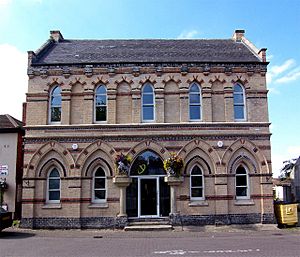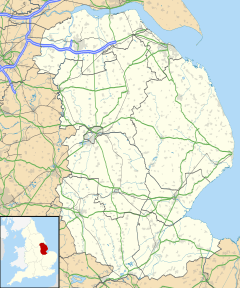Crowle, Lincolnshire facts for kids
Quick facts for kids Crowle |
|
|---|---|
 Market Hall in Crowle |
|
| Population | 4,828 (2011 Census) |
| OS grid reference | SE772128 |
| • London | 150 mi (240 km) SSE |
| Civil parish |
|
| Unitary authority | |
| Ceremonial county | |
| Region | |
| Country | England |
| Sovereign state | United Kingdom |
| Post town | Scunthorpe |
| Postcode district | DN17 |
| Police | Humberside |
| Fire | Humberside |
| Ambulance | East Midlands |
| EU Parliament | Yorkshire and the Humber |
Crowle is a small market town located in Lincolnshire, England. It is part of the Isle of Axholme, a unique area. In 2011, about 4,828 people lived here. The town sits right next to the Stainforth and Keadby Canal.
Crowle has some interesting old buildings. You can see the parish church with its special Crowle Stone runic cross. There's also a beautiful Gothic style market hall.
Contents
History of Crowle
Crowle is built on one of the hills that make up the Isle of Axholme. These hills were left behind after the last Ice Age, when a huge lake called Glacial Lake Humber dried up. The area around Crowle used to be very wet, with lots of marshland.
In the 1600s, a man named Cornelius Vermuyden changed the landscape. He was hired by King Charles I to drain the Hatfield Chase area. This project moved rivers and created many canals and ditches. This is why the area now looks a bit like the Netherlands!
Early Settlements
People have lived in this area for a very long time. We know this from old tools like stone axes found here. Pieces of Bronze Age pottery have also been discovered. In 1747, a collection of bronze spearheads was found on Crowle Moor. This shows that people lived here for thousands of years.
During the Romano-British period, there were many small farms. These were similar to those found nearby when the M180 motorway was built. The different settlements likely came together to form a community during the Anglo-Saxon period.
Crowle in the Domesday Book
The top of Mill Hill was used for farming even in Roman times. Below a certain height, the land was too wet for crops. It was mostly used for grazing animals. The town was quite important by the late 1000s. The Domesday Book from 1086 recorded 31 fisheries in Crowle.
The Domesday Book also said that Crowle was the biggest and most valuable manor in the Isle of Axholme. A "carucate" was a measure of land, about 240 acres, that a plough team could work in a year.
St Oswald's Church
The parish church, called St Oswald, was built soon after the Domesday Book was written. It has Norman architecture from the 1100s. Some older Saxon stones were reused in its walls. One special stone has carvings of serpents and dragons, and even a runic message.
The church was changed and rebuilt over many centuries. It is now a Grade I listed building, meaning it is very important. Crowle became a market town in the 1100s and 1200s. It got its first market permission in 1305.
Life in Old Crowle
Life in Crowle was mostly about farming, hunting, and fishing. The surrounding marshy areas were used for grazing animals in summer. In winter, much of the land flooded. This flooding actually helped the soil become more fertile. The flooded areas were also good for fishing and catching birds.
Land Drainage and Changes
The big drainage project by Cornelius Vermuyden in the 1620s changed Crowle a lot. It aimed to turn marshland into farmland. However, many local people lost their way of life. They used to rely on the common land for their animals, but much of it was taken away.
This caused a lot of trouble and unhappiness. The drainage didn't always work well, leading to floods in both summer and winter. Fishing and bird hunting also became harder. Eventually, the people of Crowle were given 100 acres of land to make up for their lost fishing areas.
Growth and New Ideas
Between 1590 and 1640, Crowle grew, with 40 new houses built. This growth continued through the 17th and 18th centuries. People farmed, fished, cut peat, and grew flax and hemp to make sackcloth.
Transport improved when the Stainforth and Keadby Canal was built between 1792 and 1802. This canal passed near Crowle, making it easier to transport goods. A new farming method called "warping" also became popular. This involved flooding land with tidal water to deposit rich soil, making the land more fertile.
Town Development
Crowle became very successful in the 1800s. Making sackcloth became easier with machines. There was also growth in milling, brewing, and making farm equipment. A brick and tile factory provided more jobs. By 1893, Crowle had four windmills.
The town was one of the first in the area to have a gas works, which started in 1854. This provided gas for street lighting. The fancy Market Hall, built in the late 1800s, shows how well the town was doing.
Population and Education
Crowle's population grew steadily in the 1800s. It went from 1,343 people in 1801 to 3,122 in 1871. A cemetery was opened in 1862.
Education was provided by a National School. This school was funded by money from old gifts left by people like Richard Brewer in 1687. By 1872, there were also other private schools. Many people worked in farming, but there were also blacksmiths and other trades.
Railways Arrive
The arrival of railways helped trade even more. The Axholme Joint Railway opened in 1905. It connected Crowle to Goole in the north and Haxey Junction in the south. A big part of this railway was the Crowle Swing Bridge, which went over the Stainforth and Keadby Canal.
In the mid-1900s, Crowle's economy slowed down a bit. This was partly because farming changed. However, more houses were built, and the M180 motorway was constructed nearby. This made it easier to travel to bigger towns for jobs and shopping.
In 2010, the civil parish officially changed its name to "Crowle & Ealand".
Schools in Crowle
The Axholme Academy is the main secondary school for students aged 11 to 18. Before 2012, it was called North Axholme School. In 1965, the school organized a special trip on the Axholme Joint Railway. This was just before the railway closed for good.
About 184 students and teachers rode a special train from Goole to Epworth. The trip took four hours. Primary education is available at Crowle Primary Academy and Saint Norbert's Catholic Primary Voluntary Academy.
Churches and Religion
Crowle has several churches. Besides the main St Oswald's parish church, there is a Catholic church dedicated to St Norbert. There are also chapels for Baptists, Methodists, and Congregationalists.
The Baptists have been active in Crowle since 1599. They built a chapel in 1820, which was rebuilt in 1879. It closed in 2010 due to fewer people attending. The Congregationalists built their chapel in 1880, and the Methodists built theirs in 1904.
In the mid-1800s, many Irish workers came to Crowle. There was no Catholic church for them. An Italian foreman at the gas works, James Walker, asked for help. A religious order called the Canons Regular of Prémontré came to Crowle. They built a church and a house in 1871-1872. A school was added in 1873.
Local Facilities
Crowle has many community places. These include a Library, a Community Resource Centre, and a Youth Centre. There is also a Hall and a British Legion Club. In 2015, the local council bought the Market Hall. They changed it so the youth service could use it.
The town centre has several shops. There are also a few pubs. The White Hart Inn is a very old building, dating back to the 1500s and 1600s. It is said to be the oldest inn in the Isle of Axholme. The Cross Keys Inn is another old building from the 1700s.
Media and News
You can get television signals in Crowle from either the Emley Moor or Belmont TV transmitters. Local radio stations include BBC Radio Humberside and Capital Yorkshire. There are also other stations like Greatest Hits Radio Yorkshire and Steel FM. The local newspaper for Crowle is the Doncaster Free Press.
Transport in Crowle
Buses in Crowle are run by East Yorkshire and Hornsbys Bus & Coach. These buses connect the town to Scunthorpe and Goole.
Crowle has a train station on the South Humberside Main Line. This line goes from Doncaster to Scunthorpe.
There was once another station called Crowle North railway station. It closed to passengers in 1933. This station was on the Axholme Joint Railway. The old railway line has now been turned into a path for walking and horse riding.
See also
 In Spanish: Crowle (Lincolnshire) para niños
In Spanish: Crowle (Lincolnshire) para niños


